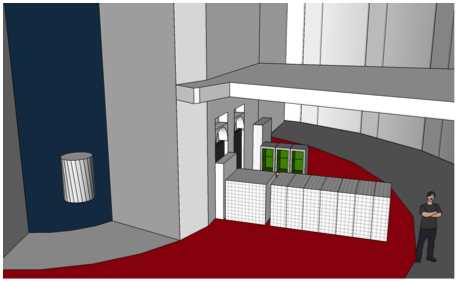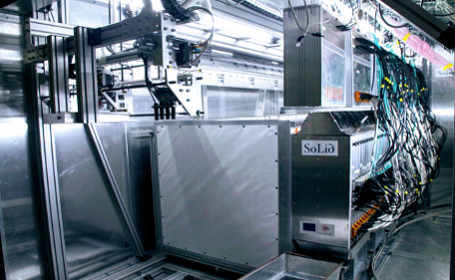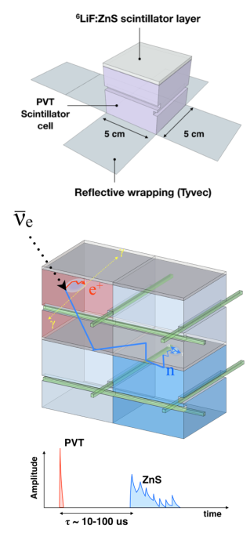Physics case
The SoLid experiment aims to address one of the most outstanding issue in neutrino physics. Recent experimental neutrino oscillation results suggest the existence of a new neutrino state. This possible new state, with a mass of around 1 eV, is called sterile because of its vanishing weak interaction quantum numbers. Its discovery would modify in depth our current understanding of the elementary interactions.
Electronic antineutrinos produced at nuclear reactors can help to shed light on this new state. The electron-to-sterile antineutrino oscillation induces a modification of the flux of the antineutrinos close to the reactor core (< 10 m). The measurement of the antineutrino flux from \(^{235}\rm U\) at short distance from the production will provide an essential reference for predictions used in current and future neutrino experiments.
SoLid experiment
The unique strengthes of the SoLid experiment relies on both the antineutrino source and the technology of detection. The detector is installed at the BR2 research reactor of \( \rm{SCK \! \cdot \! CEN (Mol,Belgium) } \), which provides a very pure source of electron antineutrino (>95 % \(^{235}\rm U\)). The experimental site allows to perform flux measurements at distance varying from 5.5 to 12 m from the core, where the modification of the flux in presence of a sterile neutrino is maximal. In addition to these beneficial characteristics, the site is distinguished by its exceptionally low background environment.
The measurement principle is based on the identification of the inverse beta decay products when an electron antineutrino interacts with a proton inside the detector \( \rm{(\bar\nu_e + p \rightarrow e^+ + n)} \). This produces a prompt signal originating from the ionization energy loss and subsequent annihilation of the positron as well as a time-delayed signal induced by the capture of the neutron after thermalisation.
In order to measure these signals, the SoLid detector is composed of detection units made of polyvinyl-toluene (PVT) cubes of 5 x 5 x 5 cm3 lined with two layers of \( \rm{ ^6LiF:ZnS(Ag) }\). The PVT cubes provide the hydrogen rich target for the electron antineutrino. They are optically isolated using Tyvek wrapping and assembled in planes of 16 x 16 units. In its final design, the SoLid detector is made of 5 modules, each of them consisting of 10 planes. The positron is detected by the scintillation light generated in the PVT cubes.
The neutron thermalises and is subsequently captured by the Li6 thus producing a \( ^3\rm H \) nucleus and an \( \alpha \) particle with a combined energy of 4.8 MeV exciting scintillation in the \( \rm{ZnS(Ag) }\) layers. This light is collected via two horizontal (vertical) fibres running through each row (column) of cubes. Each fibre is coupled to a Silicon Photon Multiplier at one end and a mirror on the other end. This enables a 3D reconstruction of all signals in any cube. The light from the PVT and \( \rm{ZnS(Ag) } \) have different decay times, allowing the positron and neutron signal to be separated.



